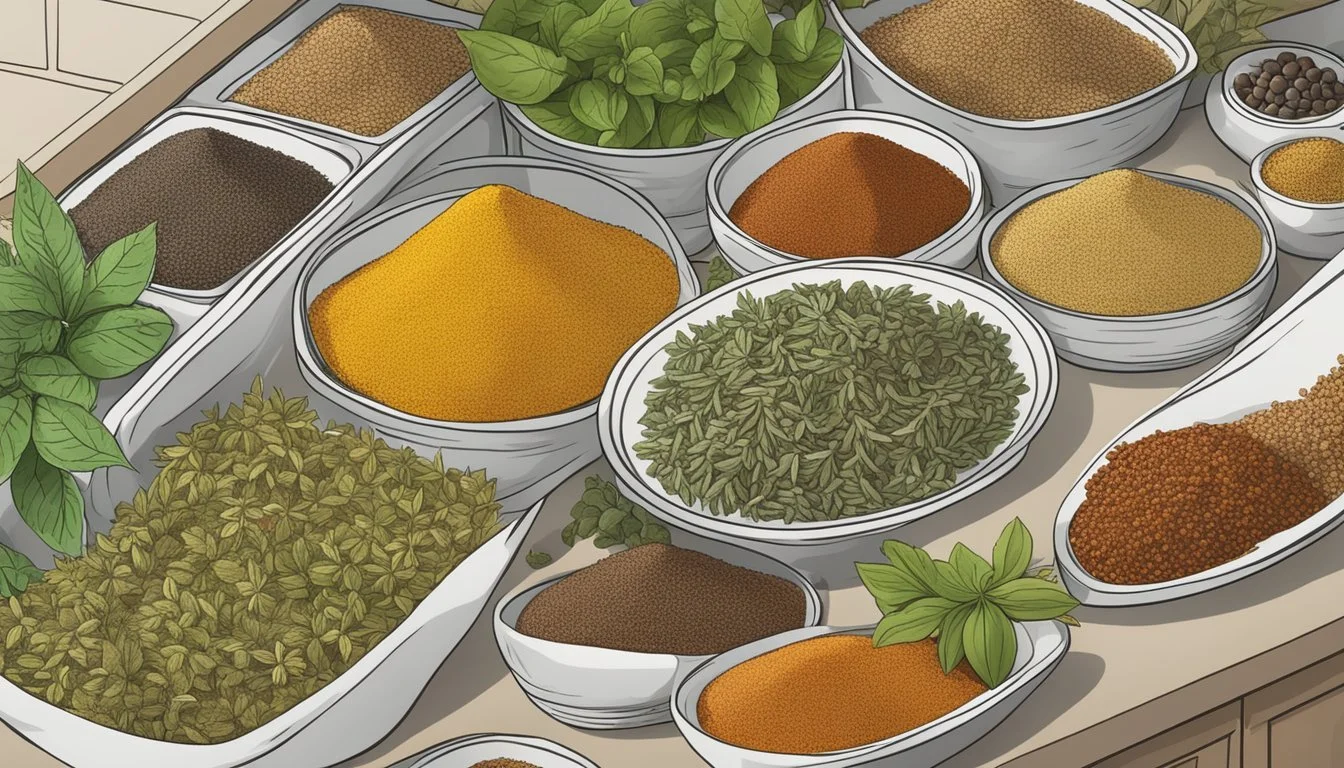Sumac Substitutes
Top Alternatives for Flavorful Dishes
Sumac, a vibrant red spice known for its tangy flavor, is a staple in Middle Eastern cuisine. When this unique ingredient is unavailable, there are several effective substitutes that can replicate its tart and sour profile with remarkable success. Za'atar, a spice mix that includes sumac, is an excellent replacement, bringing a similar flavor and a touch of complexity from its additional ingredients like oregano and sesame seeds.
Other viable substitutes include lemon zest and lemon pepper seasoning, both of which can mimic sumac's citrusy notes. Vinegar, known for its acidity, also serves as a useful alternative if used in the right quantities. These ingredients can help maintain the desired taste in your dishes when sumac is out of reach.
For those seeking a more adventurous alternative, tamarind offers a distinct sourness, while marigold syrup can add both color and flavor to sweeter creations. Each of these substitutes brings its unique twist, ensuring that your cooking retains its intended zest and appeal.
Exploring Sumac as a Spice
Sumac is a vibrant, tangy spice used in a variety of Middle Eastern dishes. Known for its earthy flavor and tartness, sumac offers unique culinary and nutritional benefits.
Historical Significance
Sumac has origins in the Middle East, where it has been utilized for centuries. Ancient civilizations favored it for its medicinal properties. Traditionally, it was used to treat a range of ailments. The spice was also cherished for its ability to add a tart, lemony flavor to foods long before lemons were widely available. Sumac's role in traditional spice blends like za’atar underscores its enduring significance in Middle Eastern cuisine.
Culinary Uses
Sumac is prized for its unique flavor profile, combining earthy, tangy, and slightly sweet notes. Its vibrant red hue makes it a popular garnish and a key ingredient in Middle Eastern dishes.
Common applications include:
Seasoning meat and fish: Adds a tartness that complements savory flavors.
Salads and dressings: Enhances freshness and adds a citrus-like note.
Spice blends: Integral to za’atar, which includes oregano, marjoram, and thyme.
Sumac can be used in both ground form and infused oils, providing versatility in the kitchen.
Nutritional Profile
Sumac is not just about flavor; it also offers nutritional benefits. It is rich in antioxidants, which help to combat oxidative stress in the body.
Key nutrients in sumac include:
Vitamin C: Supports immune health and skin vitality.
Fiber: Promotes digestive health.
Polyphenols: Known for their anti-inflammatory properties.
Incorporating sumac into a diet can enhance both the taste and nutritional quality of meals, making it a valuable addition to various cuisines.
Identifying Alternatives to Sumac
Various ingredients can effectively replace sumac in recipes, each bringing its own unique tangy flavor and acidity to dishes. The following are some of the most suitable substitutes for sumac, categorized by type and cuisine.
Common Substitutes and Their Properties
Lemon Juice: This common kitchen staple offers a tart and sour flavor similar to sumac. A tablespoon of lemon juice can replace a teaspoon of sumac. It’s excellent for salads, marinades, and sauces.
Lemon Zest: The zest of a lemon provides a less intense sourness compared to the juice. Use it in a 1:1 ratio as a sumac substitute. Best for dishes needing a subtle citrus aroma.
Orange Zest: Slightly sweeter and less tart, orange zest can be used in recipes where a milder citrus flavor is desired. Ideal for marinades and fruit-based dishes.
Spices as Sumac Substitutes
Lemon Pepper: A mix of crushed lemon zest and black pepper, this blend can replace sumac by providing a comparable tangy and slightly spicy kick. Use 1.5 times the amount of sumac needed.
Za'atar: A Middle Eastern spice mix that includes sumac, oregano, thyme, and sesame seeds. It’s perfect for Mediterranean and Middle Eastern recipes. Use it in a 1:1 ratio to maintain the dish’s authentic flavor.
Tamarind: Known for its sourness, tamarind can serve as an excellent sumac substitute in Asian cooking. Use a teaspoon of tamarind paste per teaspoon of sumac.
Substitutes by Cuisine
Middle Eastern Cuisine: Za'atar and lemon pepper are the best substitutes for maintaining traditional flavors. Both complements dishes like grilled meats and roasted vegetables.
Mediterranean Dishes: Lemon juice and lemon zest are ideal here, adding a refreshing zing to Mediterranean salads, fish dishes, and sauces.
Asian Cooking: Tamarind is widely used in Asian cuisines for its tangy and sour notes. It pairs well with sauces and stir-fries, maintaining the authentic taste profiles.
Using these substitutes can help recreate the desired tangy flavor of sumac, ensuring your dishes remain delicious and well-balanced.
Practical Tips for Using Sumac Substitutes
Using sumac substitutes effectively involves balancing the flavors and ensuring that the chosen substitute complements the dish. Here are some specific tips to guide you.
Adjusting Flavor Balance
When substituting for sumac, it's crucial to balance the flavors. Sumac is known for its tangy, slightly sour taste. Lemon zest or lemon juice can replicate this acidity. If using lemon zest, combining it with a bit of salt can help achieve the desired flavor.
Orange zest offers a sweeter alternative and can be paired with lemon zest or vinegar to mimic sumac’s tartness. For a more complex flavor, za'atar can be used. Since it includes sumac among other spices, it provides a closely related taste profile. Adjust the quantities to match the intensity of sumac in your recipe.
Suitability for Different Dishes
Selecting the right substitute depends on the dish you are preparing. For marinades, lemon juice serves as an effective sumac replacement, adding both acidity and moisture to the meat. In salads, lemon zest offers the needed tang without overpowering the fresh flavors.
Za'atar is ideal for sprinkling on hummus, falafel, and grilled meats. It not only replaces sumac but also adds depth. Lemon pepper, especially when mixed with a little salt, works well for kebabs and stews, enhancing the seasoning profile without losing the intended tartness.
Experimenting with these substitutes can help you find the perfect balance and match for various culinary creations.
Substitutes in the Kitchen Pantry
When you find yourself without sumac, several pantry staples can offer similar tart and lemony flavors to elevate your dishes. These substitutes include common household ingredients and homemade spice mixes that can add both exotic tastes and familiar tangy notes to your meals.
Household Ingredients as Substitutes
Lemon Zest and Salt: A blend of lemon zest and salt can mimic sumac's brightness. Grating fresh lemon zest and mixing it with a touch of salt provides a direct citrusy flavor.
Lemon Juice: Lemon juice is another excellent stand-in, offering a fresh and tangy bite that enhances both sweet and savory dishes. Use it in a 1:1 ratio.
Vinegar Options: Apple cider vinegar, wine vinegar, and balsamic vinegar add a sharp acidity similar to sumac. They are versatile and commonly found in most kitchens.
Tamarind Paste: For a more exotic touch, tamarind paste provides a complex, tart flavor. Use it sparingly as a little goes a long way.
Lime Juice: Similar to lemon juice, lime juice provides a zesty freshness and works well in marinades, dressings, and sauces.
Creating Homemade Spice Mixes
Za’atar: This Middle Eastern blend contains sumac, along with dried herbs like oregano, thyme, and marjoram, and sesame seeds. It's perfect on meats, vegetables, and flatbreads.
Lemon Pepper Seasoning: Combining lemon zest, black pepper, and a bit of salt, this seasoning works wonders as a sumac substitute. It's particularly good on grilled meats and seafood.
Ground Coriander: Adding ground coriander to your spice mix can provide a lemony freshness. Pair it with smoked paprika for a subtle smoky undertone and rich flavor.
Amchoor or Dried Mango Powder: This Indian spice delivers a tangy flavor, making it an excellent alternative. It's particularly effective in bringing a tart and fruity taste to your recipes.
Pomegranate Molasses: With a sweet and tangy profile, pomegranate molasses can be used in small quantities. It works especially well in dressings and marinades.
These substitutes allow flexibility and creativity in your cooking, enabling you to replicate the unique flavor profile of sumac with ingredients you likely already have in your pantry.
Finding Sumac and Its Substitutes
Sumac, a vibrant red spice, elevates Middle Eastern dishes with its tangy flavor. This section provides a guide on sourcing sumac and offers tips for proper storage to preserve its quality.
Shopping Guide for Sumac
Sumac can be found in supermarkets with well-stocked spice aisles, especially those that carry international or ethnic foods. Look for both ground sumac and whole sumac berries.
For a more authentic experience, consider visiting a specialty Middle Eastern market. When purchasing, check the ingredient list to ensure the product contains pure sumac without additives.
Online stores are another reliable source, often offering a wider variety of whole berries and powder form. Popular stores include Amazon, and specialty spice retailers.
Sumac is also an integral part of spice blends like za'atar, so exploring those blends can be beneficial if pure sumac is unavailable.
Storing Tips for Longevity
Proper storage is key to maintaining sumac’s flavor and color. Store ground sumac or whole berries in an airtight container to protect them from moisture and light.
A cool, dark pantry or cupboard is ideal for storing sumac, avoiding places like above the stove where heat can degrade the spice.
For long-term storage, dried berries can be kept in the freezer inside a sealed bag to extend their freshness.
Always label containers with the purchase date to monitor freshness. By following these tips, you can keep your sumac vibrant and flavorful for up to a year.
Health Considerations When Choosing Substitutes
Choosing the right substitute for sumac involves considering factors like allergies, dietary restrictions, and personal health goals. Each substitute offers unique flavors and nutritional profiles that might impact these considerations.
Allergy-Friendly Options
For individuals with food allergies, it's vital to avoid substitutes that might trigger a reaction. Lemon zest is a commonly suggested sumac substitute, but if someone is allergic to citrus, this wouldn't be suitable.
Za’atar includes sesame seeds which can be a common allergen. Always check ingredient lists and opt for single-ingredient alternatives like vinegar or tamarind to minimize risks.
Tamarind offers a tangy flavor similar to sumac and is generally safe for most people. However, always consult with an allergist if uncertain.
Dietary Restrictions and Preferences
When considering dietary restrictions, vegetarian, vegan, halal, and kosher diets must be kept in mind. Most sumac substitutes align well with these dietary frameworks.
Lemon pepper seasoning often contains only plant-based ingredients, making it suitable for vegetarian and vegan diets. Vinegar is another safe choice across various dietary preferences and is also gluten-free.
For those following halal or kosher diets, it's essential to ensure that the replacement adheres to these guidelines. Typically, vinegar and lemon zest are compliant, but always verify certifications.
Nutrition is another key concern. Substitutes like tamarind not only replicate the acidity of sumac but also add beneficial nutrients such as magnesium, potassium, and vitamins. Lemon zest is rich in vitamin C and antioxidants, contributing positively to overall health.
Enhancing Dishes Beyond Flavor
Sumac substitutes not only replicate the tart flavor but can also enhance the color and texture of dishes. These additions can transform the presentation and mouthfeel, making meals more visually appealing and enjoyable.
Color and Presentation
The color and presentation of a dish can be elevated using certain sumac substitutes. Lemon zest, for instance, adds a hint of yellow, brightening salads and grilled dishes. Za'atar, a mix including sumac, provides a rich combination of green herbs and spices, creating a visually appealing garnish on meats and vegetables.
Dried tart cherries introduce a vibrant red hue, suitable for both sweet and savory applications. These cherries not only enhance color but also contribute a contrasting tart flavor. Marigold syrup or extract, with its vivid yellow-orange tint, can also be used to decorate desserts or infuse sumac-infused oils for a colorful drizzle.
Texture and Mouthfeel
The texture and mouthfeel of dishes are equally important. Lemon pepper mixture, when used as a seasoning, adds a granular texture that can complement grilled proteins. The combination of crunch from the pepper and the burst of citrus can elevate the overall eating experience.
Horseradish, another substitute, offers a sharp and intense mouthfeel, pairing well with hearty dishes. When used in moderation, horseradish can create a creamy texture when mixed into sauces or dips.
Sumac-infused oil, using marigold petals, provides a smooth and rich texture, ideal for drizzling over salads or pasta. This method subtly incorporates the desired flavor profile while adding a slight, luxurious mouthfeel to the dish.







